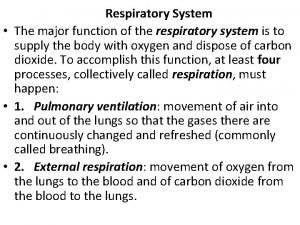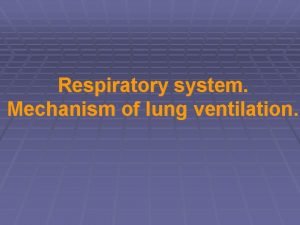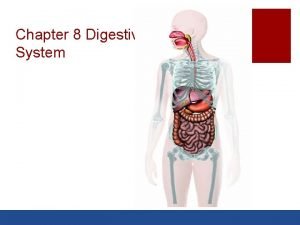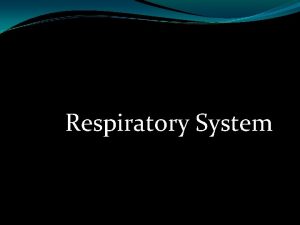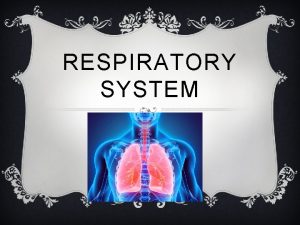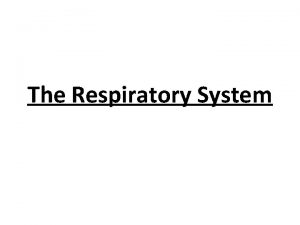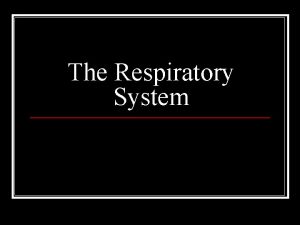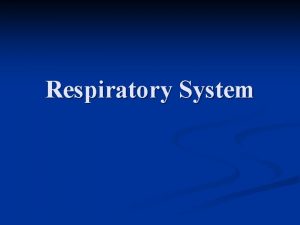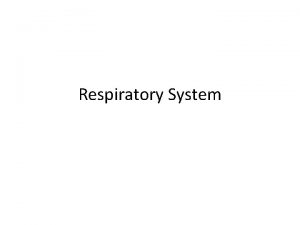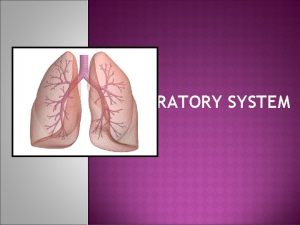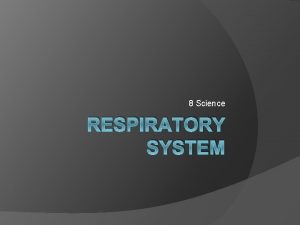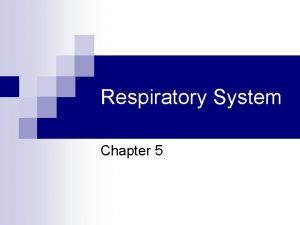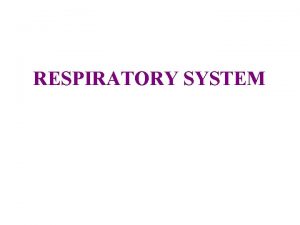Respiratory System Respiratory System Function Outcomes The respiratory























- Slides: 23

Respiratory System

Respiratory System Function Outcomes � The respiratory system has one main function. � It is to exchange oxygen and carbon dioxide in the lungs. ◦ ◦ Oxygen is brought into the body. Carbon dioxide is removed. Water is also exhaled. Carbon dioxide and water are wastes produced during cellular respiration.

Path of the air � The air comes in from the outside environment through the following structures: ◦ ◦ Nose Pharynx Trachea Lungs �Bronchus �Alveoli

� Air Nose enters and exits the body through the nose. (Unless you are a mouth breather. ) The nose is lined with hairs and mucus. �Hair- cilia, help trap unwanted material (dust, bacteria) �If the cilia is irritated, you SNEEZE.

Cilia � These fine hairs sweep foreign particles up to the nose or mouth. � From there, they're swallowed, coughed, or sneezed out of the body. � Nose hairs and mouth saliva also trap particles and germs.

Pharynx - Outcomes � After the air enters the nose it passes through the pharynx (throat). ◦ The pharynx shares this area with the digestive system and is separated by the epiglottis.

WARNING!!! � Graphic slide coming.

Infected Pharynx from Mono

Trachea - Outcomes � From the pharynx the air moves into the trachea (windpipe). ◦ What flap of tissue protects food from entering the trachea? �Epiglottis ◦ The trachea is lined with cilia and mucus that captures unwanted particles. ◦ When the lining of your trachea is irritated, you COUGH.

WARNING!!! � Graphic slide coming.

Trachea � The trachea is held open by cartilage rings. � You can feel these rings on the front of your throat.

Bronchi and lungs - Outcomes � The air then moves through the trachea to the bronchus, this is where the trachea splits into two bronchi, one for each lung.

Bronchus / Bronchioles � The air continues down each bronchi (one in each lung). � As the airway passages make their way out to the lung tissue, the passages become smaller and are referred to as bronchioles. � Eventually the bronchioles terminate into small collections of air sacs known as alveoli.

Alveoli � These sacs look like bunches of grapes. � The purpose of the alveoli is to increase surface area. � On average there are 300 million alveoli in an adult human.

ALVEOLI � Each of these air sacs is covered in tiny blood vessels called capillaries. � The capillaries connect to a network of arteries and veins that move blood through your body. � This is where oxygen is exchanged into the blood stream.

Gas exchange video– Outcomes � After air enters an alveolus, oxygen passes through the wall of the alveolus and then through the capillary wall into the blood. Carbon dioxide and water pass from the blood into the alveoli. This exchange happens because of cellular respiration!

Lungs � Lungs are saclike respiratory organs in the chest of vertebrates. � The bronchi lead the air to the lungs. � The lungs are divided into five main sections called lobes. � Some people need to have a diseased lung lobe removed. However, they can still breathe well using the rest of their lung lobes.

WARNING!!! � Graphic slide coming.

� The Lungs - Outcomes lungs are the main organ of the respiratory system. � The right lung is slightly larger than the left lung. Why is that?

How do we breathe? - Outcomes � The lungs are surrounded by our rib cage. Below the rib cage we have a large smooth muscle known as the diaphragm. � The diaphragm is a dome-shaped muscle located below your lungs. It separates the chest cavity from the abdominal cavity. The diaphragm is the main muscle used for breathing. How does the diaphragm work?

How do we speak? � Think of a balloon. If you hold the air inside and you release it slowly it will make a high squeaking noise. � This is due to the air coming out and causing the edges of the balloon to vibrate. � The same is true with your larynx.

WARNING!!! � Graphic slide coming.

Larynx � The air that moves through our lungs also helps us speak. � Larynx-(voice box) The hollow muscular organ forming an air passage to the lungs and holding the vocal cords. � Larynx video clip Please listen carefully.
 Respiratory zone and conducting zone
Respiratory zone and conducting zone Digestive system circulatory system and respiratory system
Digestive system circulatory system and respiratory system Upper respiratory tract
Upper respiratory tract Spirogram diagram
Spirogram diagram Larynx respiratory system
Larynx respiratory system Pharynge
Pharynge Triangle outcome star
Triangle outcome star Hát kết hợp bộ gõ cơ thể
Hát kết hợp bộ gõ cơ thể Frameset trong html5
Frameset trong html5 Bổ thể
Bổ thể Tỉ lệ cơ thể trẻ em
Tỉ lệ cơ thể trẻ em Voi kéo gỗ như thế nào
Voi kéo gỗ như thế nào Tư thế worm breton là gì
Tư thế worm breton là gì Alleluia hat len nguoi oi
Alleluia hat len nguoi oi Môn thể thao bắt đầu bằng từ đua
Môn thể thao bắt đầu bằng từ đua Thế nào là hệ số cao nhất
Thế nào là hệ số cao nhất Các châu lục và đại dương trên thế giới
Các châu lục và đại dương trên thế giới Công thức tính độ biến thiên đông lượng
Công thức tính độ biến thiên đông lượng Trời xanh đây là của chúng ta thể thơ
Trời xanh đây là của chúng ta thể thơ Mật thư anh em như thể tay chân
Mật thư anh em như thể tay chân Phép trừ bù
Phép trừ bù độ dài liên kết
độ dài liên kết Các châu lục và đại dương trên thế giới
Các châu lục và đại dương trên thế giới Thơ thất ngôn tứ tuyệt đường luật
Thơ thất ngôn tứ tuyệt đường luật


